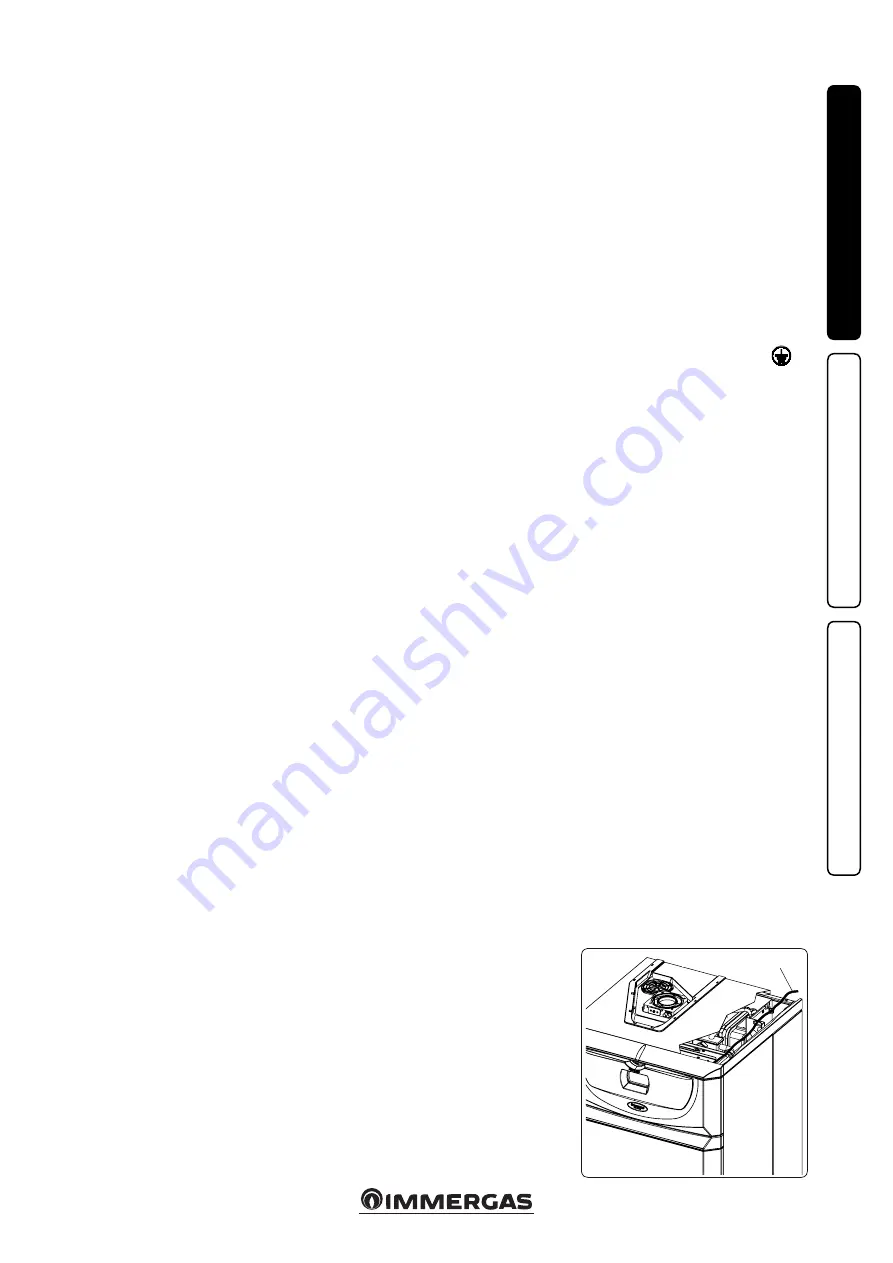
CAVO ALIMENTAZIONE
1-2
7
INS
TALLER
US
ER
MAINTEN
AN
CE TECHNI
CI
AN
1.3 GAS CONNECTION.
Our boilers are designed to operate with methane
gas (G20) and LPG. Supply pipes must be the
same as or larger than the 3/4”G boiler fitting.
Before connecting the gas line, carefully clean
inside all the fuel feed system pipes to remove
any residue that could impair boiler efficiency.
Also make sure the gas corresponds to that for
which the boiler is prepared (see boiler data
name plate). If different, the appliance must
be converted for operation with the other type
of gas (see converting appliance for other gas
types). The dynamic gas supply (methane or
LPG) pressure must also be checked accord-
ing to the type used in the boiler, which must
comply with the technical standards in force, as
insufficient levels can reduce generator output
and cause malfunctions. Ensure correct gas cock
connection. The gas supply pipe must be suitably
dimensioned according to current regulations
in order to guarantee correct gas flow rate to the
burner even in conditions of maximum genera-
tor output and to guarantee appliance efficiency
(technical specifications). The coupling system
must conform to technical standards in force.
Fuel gas quality.
The appliance was designed
to operate with combustible gas free of impuri-
ties; otherwise it is advisable to fit special filters
upstream of the appliance to restore the purity
of the fuel.
Storage tanks (in case of supply from LPG
depot).
- New LPG storage tanks may contain residual
inert gases (nitrogen) that degrade the mixture
delivered to the appliance casing functioning
anomalies.
- Due to the composition of the LPG mixture,
layering of the mixture components may occur
during the period of storage in the tanks. This
can cause a variation in the heating power of
the mixture delivered to the appliance, with
subsequent change in its performance.
1.4 HYDRAULIC CONNECTION.
Attention:
in order not to void the condensa-
tion module warranty, before making the boiler
connections, carefully wash the heating system
(pipes, radiators, etc.) with special pickling or
descaling products to remove any deposits that
could compromise correct boiler operation.
A treatment of the heating and water system wa-
ter is required, in compliance with the technical
standards in force, in order to protect the system
and the appliance from deposits (e.g. scale),
slurry or other hazardous deposits.
Water connections must be made in a rational
way using the couplings on the boiler template.
The boiler safety valves outlet must be connected
to a draining funnel. Otherwise, the manufactur-
er declines any responsibility in case of flooding
if the drain valve cuts in.
Attention:
Immergas declines all liability in the
event of damage caused by the inclusion of auto-
matic filling that is not its own brand.
In order to meet the system requirements es-
tablished by the technical regulation in force in
relation to the pollution of drinking water, we
recommend installing the IMMERGAS anti-
backflow kit to be used upstream of the cold
water inlet connection of the boiler. It is also
recommended that the heat transfer fluid (e.g.
water + glycol) entered in the primary circuit
of the boiler (heating circuit), complies with the
local regulations in force.
Attention:
to preserve the duration and the ef-
ficiency features of the appliance, in the presence
of water whose features can lead to the deposit of
scale, installation of the “polyphosphate dispenser”
kit is recommended.
Condensate drain.
To drain the condensate
produced by the appliance, it is necessary to
connect to the drainage system by means of acid
condensate resistant pipes, with an internal Ø of
at least 13 mm. The system connecting the appli-
ance to the drainage system must be carried out
in such a way as to prevent freezing of the liquid
contained in it. Before appliance ignition, ensure
that the condensate can be correctly removed.
After first ignition, check that the drain trap is
filled with condensate (para. 1.20). Also, comply
with national and local regulations on discharg-
ing waste waters.
In the event condensate is not discharged into
the wastewater drainage system, a condensate
neutraliser must be installed to ensure compli-
ance with the parameters established by the
legislation in force.
1.5 ELECTRICAL CONNECTION.
The boiler has an IPX5D protection rating for the
entire appliance. Electrical safety of the appliance
is reached only when it is correctly connected to
an efficient earthing system as specified by cur-
rent safety standards.
Attention:
Immergas S.p.A. disclaims any li-
ability for damage or physical injury caused
by failure to connect the boiler to an efficient
earthing system or failure to comply with the
reference standards.
Also ensure that the electrical installation cor-
responds to maximum absorbed power specifi-
cations as shown on the boiler data nameplate.
Boilers are supplied complete with an “X” type
power cable without plug.
The power supply cable must be connected to
a 230V ±10% / 50Hz mains supply respecting
L-N polarity and the earth connection
on
this network must also feature a multi-pole
circuit breaker of class III overvoltage category.
When replacing the power supply cable, contact
a qualified firm (e.g. the Authorised After-Sales
Technical Assistance Service).
The power cable must be laid as shown (Fig. 1-2).
In the event of mains fuse replacement on the
P.C.B., use a 3.15A quick-blow fuse. For the main
power supply to the appliance, never use adapt-
ers, multiple sockets or extension leads.
Installation with system operating at direct
low temperature.
The boiler can directly feed a
low temperature system by acting on parameter
“P66” (Par. 3.8) and setting the delivery tempera-
ture adjustment range “P66/A” and “P66/B”. In
this situation it is good practice to insert a safety
device in series with the power supply and boiler.
This device is made up from a thermostat with
a temperature limit of 60°C. The thermostat
must be positioned on the system flow pipe at
a distance of at least 2 metres from the boiler.
SUPPLY VOLTAGE CABLE






















